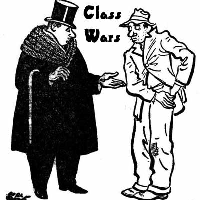San Francisco and Rwanda Are Equals When It Comes to Income Inequality

It's one thing for your city to be singled out as the second-worst in the nation for income inequality. It's another to match up unfavorably with Rwanda.
But that was the message from the San Francisco Human Services Agency at the city’s annual Family Economic Success Forum, where success for the lower economic end of an increasingly stratified region is measured in comparisons to Third World nations.
The agency used 2012 data from the U.S. Census Bureau’s American Community Survey to calculate the city’s Gini coefficient, a poverty measure conjured up in 1912 by Italian statistician and sociologist Corrado Gini. And that was before the raging tech boom of the past 18 months.
The dense formula is employed by the World Bank and is the most commonly used measure of inequality. Although the numbers are computed as fractions to lie along a range from 0 to 1, they are commonly multiplied by 100 and expressed in a 0-100 range. Zero corresponds to perfect equality and 100 with perfect inequality.
Gini can be a bit misleading as a straightforward poverty measure because if everyone in a country is poor it could get a decent rating. Afghanistan earns a 27.82, not far behind the leaders. Sweden has the most income equality at 25, followed by Norway (25.79).
It also can be misleading to use World Bank numbers to compare one country to another because ratings are not computed every year for every country. They range from 2000 to 2011. The numbers can be volatile, depending on economic and social conditions. Germany was given a 28 rating in 2000 and 41.34 in 2008.
San Francisco notches a 51, right there with Rwanda (50.82), Costa Rica (50.73) and Swaziland (51.49). It could be worse. The Republic of Seychelles has the greatest income inequality (65.77), followed by Comoros (64.3), Namibia (63.9) and South Africa (63.14).
The Brookings Institution used a different measure of income inequality in a study released three months ago that listed three California cities in the nation’s Top Ten for most gaping income disparity. San Francisco was second, Oakland was seventh and Los Angeles was ninth. Brookings measured inequality by using the “95/20 ratio.” The measurement is derived by first determining “the income at which a household earns more than 95 percent of all other households” and the “income at which a household earns more than only 20 percent of all other households.” The first number is divided by the second number and reveals the chasm between the haves and have-nots.
San Francisco may only rank second in the Brookings ratings, but it is trying harder than the rest. San Francisco showed the largest increase in income inequality, by far, between 2007 and 2012. But the best may be yet to come.
The Human Services Agency also noted in its report, according to the San Francisco Chronicle, that it’s not just a case of the rich getting richer, although they are. Much richer. Or the poor getting poorer. They are, too. Fifteen percent of San Franciscans lived in poverty in 2012, compared to 10.5% five years earlier.
But it’s the evisceration of the once-vast middle class that is skewing the inequality statistics. The percentage of people earning between 50% and 150% of the city’s median income of $72,500 has declined from 45% in 1990 to 34% in 2012.
–Ken Broder
To Learn More:
Income Inequality on Par with Developing Nations (by Heather Knight, San Francisco Chronicle)
New Data Highlights Household Income Disparity in SF (by Laura Dudnick, San Francisco Examiner)
Exploring Economic Inequality from the Heart of the Tech Boom (by Elise Hu, Nationa Public Radio)
3 California Cities Among Top 10 in U.S. with Most Income Inequality (by Ken Broder, AllGov California)
- Top Stories
- Controversies
- Where is the Money Going?
- California and the Nation
- Appointments and Resignations
- Unusual News
- Latest News
- California Forbids U.S. Immigration Agents from Pretending to be Police
- California Lawmakers Urged to Strip “Self-Dealing” Tax Board of Its Duties
- Big Oil’s Grip on California
- Santa Cruz Police See Homeland Security Betrayal in Use of Gang Roundup as Cover for Immigration Raid
- Oil Companies Face Deadline to Stop Polluting California Groundwater





